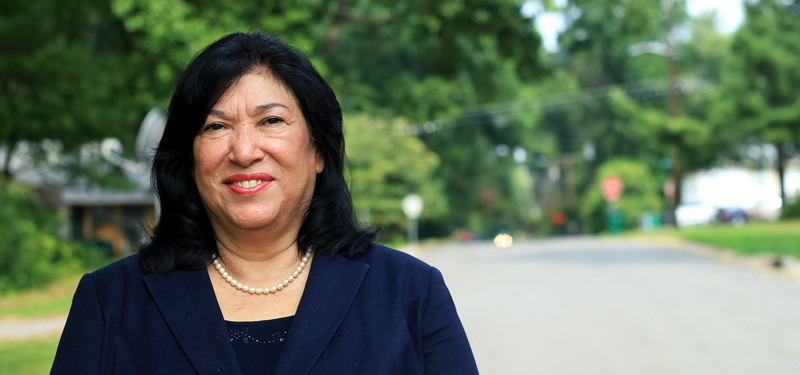Residents of a north Charlotte neighborhood are investing in communication to strengthen their community, and their early work in bilingual programs shows promise for neighborhoods throughout the city.
Diane Garris has lived for 38 years in Eastwood Acres, a neighborhood just east of Garinger High School. The neighborhood was developed five miles north of uptown Charlotte in the 1940s and 1950s. The neighborhood includes red brick, single-family, ranch-style homes, and the area is rich with history. The oldest surviving structure in Mecklenburg County is nearby — the Hezekiah Alexander homeplace – and the neighborhood borders the old Potter’s Road, dating to the 1700s.
Garris now leads its community association.
“This has always been an area that was just full of pride, and family meant a lot. Our heritage means a lot. And over the years I recall, probably in the 1980s, when you began to see a lot of families not just in our community but all over the city start to leave and move further out into the suburbs, properties were being sold to investors,” Garris says. “As investors would buy, more and more folks would leave, and I couldn’t do that. This was my home, this was my community, this was a place that I was deeply rooted in.” Sometimes, Garris says, investors have purchased houses as rental properties but have not invested in renovation. In other cases, older homeowners on fixed incomes lack resources to make improvements.
To strengthen the community, Garris and other neighborhood leaders approached the City of Charlotte’s Neighborhood and Business Services organization. A city organizational grant helped, because the neighborhood has no homeowner’s association dues. The neighborhood now offers a website that is accessible on both personal computers and smartphones. It created an online community on Nextdoor, a national social media website-building tool for neighborhoods. And it now offers bilingual communication in English and Spanish, including periodic community newsletters and outdoor organizational signs.
A year ago, the neighborhood organized a community cleanup day supported by Jesus Ministry, a Charlotte-based Latino organization.
“We were able to determine that we had a 40 percent Hispanic population in our community and in the adjacent community next to us,” Garris says. “So it was very important for us to try and reach out to all of these folks to try and bring them into the fold and rebuild community.” Eastwood Acres and the City of Charlotte works with the Jesus Ministry on translation programs and neighborhood revitalization projects.
Executive Director Maudia Melendez says the non-profit organization helps the Latino community engage with other communities and serves as a bridge to government.
“Sometimes the organization that wants to work with the community doesn’t have the resources to translate materials into Spanish,” Melendez says. “So we serve as one of the organizations that helps translate the material. It’s very, very important because people can see what’s going on in their neighborhood and gain knowledge of what’s happening and be connected through reading that material.
“Sometimes the Latino community is disconnected because of the language barrier. Many of the people in the community speak another language or they don’t speak English. And I believe that when you don’t know what the other person is saying, the material you have in your hands is irrelevant to you because you don’t understand. Emotionally and psychologically people begin to disconnect. So when they come and ask for information, that information is not in their language, it creates that barrier.”
Melendez recommends that other neighborhoods and organizations considering new bilingual programs keep their messages short and simple, at a sixth-grade educational level. She suggests using pictures and visuals, and says the Charlotte Latino community is active on Facebook.
Garris is hopeful about the impact of new communication and revitalization programs on Eastwood Acres. A new blue line extension of the Charlotte Area Transit System will be located a half-mile away. The neighborhood recently partnered with 11 other organizations along Shamrock Drive to obtain a public arts grant, which helps strengthen community identity. The community association informs residents about financial assistance programs for home upgrades and lead-based-paint abatement programs. Neighborhood leadership regularly explores collaboration and partnership with other community organizations and recently participated in a citywide board retreat for neighborhood leaders.
“Other communities have been through these challenges and they’ve found their way out,” Garris says. “That’s what we’re really doing now. We’re working to try and find what’s our way through this, to try and find that way where we turn the corner and become that desirable place where people want to live again.”
